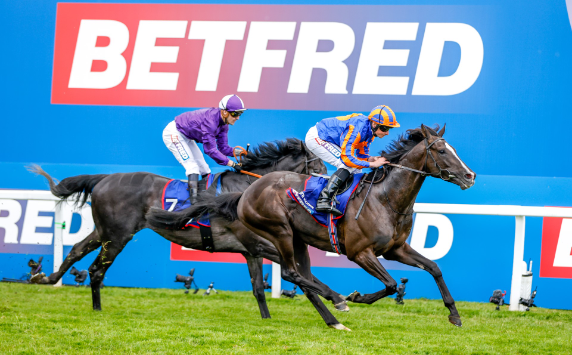Legacies of ill fated champions
There is a saying in racing that if a stallion dies his progeny comes good. Like many sayings, it is rather tongue in cheek.
However, there have been many sires, whose offspring have come good after the sire suffers an untimely demise.
A horse who certainly falls into the category of dying prematurely was the late Saint Ballado (Halo). Champion sire in the USA in 2005, Saint Ballado died when he was just 13 years old. Sadly, the same fate awaited two of Saint Ballado’s top sons, Saint Liam and Sunriver. Both stallions died young, leaving one full crop of foals apiece. Saint Liam, a former Horse of the Year, left just 88 foals, but seven have become stakes winners. Three are graded winners, and one, Havre de Grace, is a multiple G1 winner whose is a strong contender for US Horse of the Year honours in 2011.
Ironically enough, Saint Liam’s best son, Buddy’s Saint, broke down and had to be euthanized as a 3yo, before he had a chance to go to stud.
Sunriver’s only crop of foals, which are now two, include Weemissfrankie, winner of the G1 Del Mar Debutante Stakes.
One can but wonder what might have been for Saint Ballado and sons if they had enjoyed longer stud careers.
There have been many other stallions to die young, leaving just one or two crops behind. This happened to two of the sport’s greatest performers, Dubai Millennium (Seeking The Gold) and Shergar (Great Nephew).
Dubai Millennium died of grass sickness after just one year at stud. His 56 live foals included five stakes winners (10%), which include Dubawi. A triple G1 winner on the track, Dubawi has since gone on to prove himself as one of the world’s leading stallions.With his oldest crop now four, Dubawi has been represented by G1 winners, which includes 2000 Guineas winner and young sire Makfi. His offspring have won or been runner up in both of the last two 2000 Guineas, and his current 3yos include the G1 German Derby winner Waldpark.
Shergar, by comparison, failed to leave a major son behind. A brilliant 10 length winner of the Epsom Derby, Shergar was kidnapped whilst standing at stud, and was never found again. From just 35 foals, Shergar left behind five stakes winners, which included the Irish St Leger Authaal and the classic placed filly Maysoon.
Another stallion to prove very successful from relatively few number of foals was the 1979 Epsom Derby winner Troy. He had only four smallish crops (they averaged 29), but from 117 foals, Troy sired 13 stakes winners (11 percent). Of his 13 stakes winners, five were graded. His G1 winners Helen Street (Irish Oaks) and Walensee (Prix Vermeille) also made their marks at stud, with Helen Street producing Dubai World Cup winner and champion sire Street Cry (Machiavellin), while Walensee produced multiple G1 winner and Arc runner up Westerner (Danehill) .
Troy is also broodmare sire of champions Fine Motion (Danehill), Pilsudski (Polish Precedent) and Pelder (Be My Guest), whilst 1999 Epsom Derby winner Oath (Fairy King) is out of the Troy mare Sheer Audacity.
Locally, there have also been a number of highly promising sires who have died too soon. Rollins, who is best known as the broodmare sire of Jet Master, left behind five crops but they contained just 93 foals. However, from these 93 youngsters, Rollins sired nine stakes winners (ie 10% percent of Rollins’ foals were stakes winners). No fewer than 21 of Rollins’ offspring were stakes placed – an impressive 23% in other words.
His foals included G1 winner Love of London, smart galloper and sire Raise A Raucus, and, of course, Jet Lightning.
These are impressive numbers when considering they were produced from under 100 foals.
Where do SA’s top horses come from?
It is a well documented fact that a good horse can come from anywhere. Many top horses have been imported into this country, while others are raced by their breeders, or sold privately. The remainder go through the sales ring at some stage in their development.
Of the 11,588 horses born between 2004 and 2008, 16.4% of the population went under the hammer at the National Yearling Sale.
There have been 63 individual G1 winners bred in this country in the years 2004 to 2008. The years 2009 and 2010 involve horses still to young to have completed statistics.
Of these 63 top level winners, no fewer than 39 were bought at the National Yearling Sale. This means that a staggering 61% of G1 winners bred during the period of 2004 and 2008 came off the National Sale.
It is remarkable to think that over a period of four years, nearly two thirds of the country’s top horses all come off one sale.
Park Hill ties to South Africa
Meeznah, the impressive winner of Friday’s G2 and one of the top stayers in the world, has strong ties to several local thoroughbreds. Meeznah is a half-sister to Summerhill Stud’s broodmare, Deceptive Charm. The pair are out of Sadler’s Wells mare String Quartet, breeding which makes Deceptive Charm bred on the world-famous cross responsible for such high-class horses as Henrythenavigator (2000 Guineas), Divine Proportions (French Oaks), El Condor Pasa(Horse of the Year) and Virginia Waters (1000 Guineas).
String Quartet, herself, is an own sister to successful local sire, Casey Tibbs, the latter sire of such high-class performers as ill-fated champion Big City Life, Festive Occasion (SA Oaks), Cree Lodge (Winter Derby) and Heat Of the Night (Langerman Hcp).
This is also the family of local sire Vision of Grandeur, a son of Grand Lodge, whose dam, Champaka, is a half-sister to Casey Tibbs and String Quartet.








